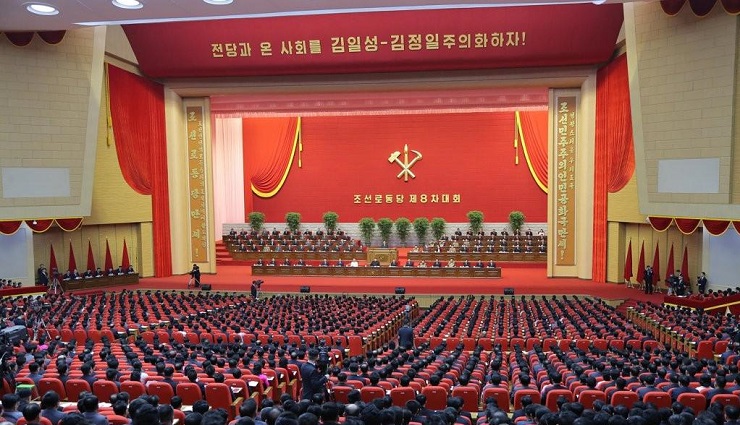Kim Jong-un keeps his word: the moratorium on nuclear tests and ICBM launches was a verbal statement. That never became a legal document, but it continues to be enforced. The same goes for promises to increase military capabilities: the leader’s speech on the subject set a number of ambitious targets.
According to the Proceedings of the 8th Congress of the Korean Workers’ Party, “The following objectives are on the agenda: To develop and introduce hypersonic surface-to-air warheads in the near future; develop solid-propellant submarine and land-based ICBMs; possess a nuclear submarine and strategic submarine-launched nuclear weapons essential to boost long-range nuclear strike capability…; using a military reconnaissance satellite, improve intelligence-gathering capability and truly accelerate the research process for the development of unmanned reconnaissance aircraft capable of conducting accurate frontline reconnaissance to a depth of 500 km and other reconnaissance means.”
The DPRK launched a cruise missile in September 2021 followed by a short-range missile test from an atomic train. But Pyongyang’s unexpected moves did not stop there, and on 28 September North Korea launched a short-range missile towards the Sea of Japan that appears to be hypersonic. According to a spokesman for the ROK Joint Chiefs of Staff, “South Korean and US intelligence agencies are analyzing the technical characteristics of the projectile.”
The Korean Central News Agency (KCNA) described the launch as a test of a new hypersonic missile, the Hwasong-8, observed by Pak Jong-chong, a member of the Presidium of the Political Bureau of the Central Committee of the Workers’ Party of Korea, and Park Jeong-cheon, Secretary of the Party Central Committee, together with senior defense science personnel. As a result of the test launch, all the planned specifications met the design requirements.
So, the DPRK has once again raised the bar for its adversaries. Firstly, a hypersonic missile means significantly higher speed, which increases its resistance to enemy missile defense systems. Secondly, the “missile’s ampoule fuel system,” mentioned in the KCNA statement, allows for long periods of liquid fuel storage inside the missile and radically improves its combat readiness by reducing pre-launch preparation.
President Moon Jae-in, at an emergency meeting of the National Security Council over the launch, expressed regret, but the word “provocation” was heard only in the opposition media.
The US, through the State Department, condemned the missile launch as violating UN Security Council resolutions, but reiterated that Washington remains committed to a diplomatic approach towards North Korea and calls on it to dialog. The State Department issued a similar statement on September 15, when North Korea launched two short-range ballistic missiles.
The US Indo-Pacific Command said in a separate statement that the firing underscored the destabilizing impact of the DPRK’s illegal weapons program, although it posed no immediate threat to the US and its allies. Again, in almost the same words as about the last launch.
Experts, however, pointed out that the launch came just days after Pyongyang announced the prospect of an inter-Korean summit if the South abandons its double standards and hostile attitude. And on the launch day, North Korean Ambassador to the UN Kim Song reiterated his country’s position, saying it had a fair right to develop and test weapons because of US and ROK threats, and called on the US to permanently stop joint exercises with South Korea and the deployment of strategic weapons in the South. So, they saw the missile as a test of Seoul’s response – in case the same rhetoric condemning provocations continues, then the current stagnation in communications between the two Koreas will go on.
As Professor Yang Mu-jin suggests, the North is waiting for a moment when South Korea and the US do not describe the North Korean missile launch as a threat or provocation. And such a moment could be a turning point for Pyongyang to re-engage with Seoul and participate in further talks.
Another topic of discussion among experts is what was launched after all. Professor Kim Dong-yup thinks the North may have tested a hypersonic gliding vehicle (HGV) launched from a ballistic missile (roughly speaking, something like a warhead, not a hypersonic cruise missile (HCM) proper). In addition, North Korea stated that the missile was named “Hwasong-8”, all missiles with that name were liquid fuel ballistic missiles. According to military analyst Shin Eui-kyung, as HGVs follow a much flatter and lower trajectory than traditional ballistic missiles, they are difficult to detect and intercept because once the gliding projectile separates from the missile, its trajectory can be unpredictable. However, according to Shin and others in the military, North Korea’s alleged hypersonic missile technology appears to be at an early stage because the Hwasong-8 flew less than 200 kilometers at just under Mach 2.5. The ROK Joint Chiefs of Staff believe the missile flew faster, at around Mach 3, but hypersonic missiles from developed nations typically fly at least Mach 5, or 6,125 kilometers per hour, leaving little time for the enemy to respond. The US, China and Russia are developing hypersonic weapons, and the North Korean version is significantly inferior to theirs. The military therefore stated that the DPRK’s hypersonic missile appears to be in an early stage of development and could be intercepted by ROK and US military means.
As for the contribution of the Hwasong-8 to the regional arms race, it should not be forgotten that both sides are making efforts to this end: in September 2021 South Korea announced the successful test of a submarine-launched ballistic missile, unveiled the development of a supersonic cruise missile, and launched another 3,000-ton-class submarine capable of launching SLBMs.
And when it comes to the contribution of the September fireworks to the containment strategy, the author has little doubt that sooner or later Pyongyang will keep the rest of its promises too.
Konstantin Asmolov, PhD in History, leading research fellow at the Center for Korean Studies of the Institute of the Far East at the Russian Academy of Sciences, exclusively for the online magazine “New Eastern Outlook”.

